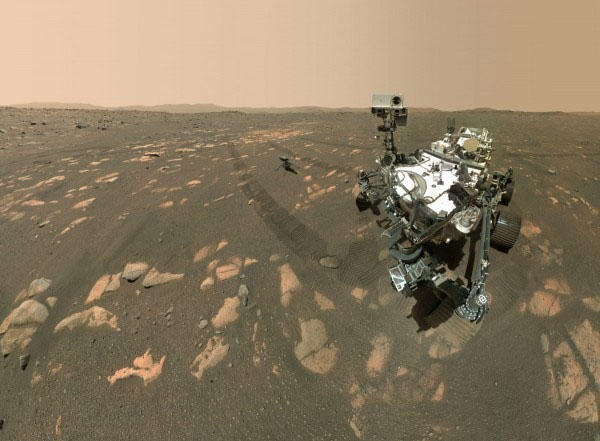| Apr 01, 2022 |
Perseverance analyzes the first sounds from Mars
|
|
(Nanowerk News) The NASA Perseverance rover, which has been exploring the Jezero Crater on Mars since February 2021, has recorded the acoustic environment of the red planet for the first time.
|
|
Using the SuperCam microphone developed at Los Alamos National Laboratory and a consortium of French universities under the Centre National D’Etudes Spatiales, an international research team published the first analysis of these sounds April 1 in Nature ("In situ recording of Mars soundscape").
|
|
“For the first time we were able to record the sound environment of the red planet between 20 hertz and 20 kilohertz, which is the audible range for humans,” said Baptiste Chide, a post-doctoral fellow at Los Alamos National Laboratory and author on the paper. “We discovered a totally new acoustic environment. Being able to record these sounds helps us better understand the behavior of sound on the Martian surface and helps us learn more about the atmosphere of the planet.”
|
 |
| The Perseverance with the Ingenuity helicopter on Mars on April 7, 2021. (Image: NASA/JPL-Caltech/MSSS)
|
|
While missions to Mars have been returning images from the red planet for nearly 50 years, all have been silent; no microphone had been able to record the acoustic environment associated with the Martian landscape until now.
|
|
Researchers believed that studying the Martian soundscape could contribute to the understanding of the planet, which led to the development of two microphones for the Perseverance mission; one that was provided by NASA’s Jet Propulsion Laboratory and the SuperCam microphone, which was provided by the Institut Supérieur de l'Aéronautique et de l'Espace in France.
|
|
The recordings revealed that Mars is a quiet planet, Chide said. Besides the wind and the turbulence of the atmosphere, natural sources are not very abundant. “With these recordings of the wind, researchers have been able to correlate the sound with variations in the wind flow, shedding light on wind gusts at very short timescales for the first time,” he said.
|
|
But the Perseverance rover has its own sound sources, including the SuperCam laser, zapping rocks on the surface and the Ingenuity helicopter, flying over the Jezero crater.
|
|
While the behavior of sound is well known on Earth, sound propagation (or how sounds travels) in the Martian atmosphere is far less understood and was only predicted by uncertain theoretical models.
|
|
From the recordings, scientists found that sound attenuation—the measure of sound’s energy loss as it travels—was stronger on Mars than on Earth. The propagation of sound differs according to the different frequencies; high frequencies are lost very quickly at short distance, contrary to the low frequencies. This difference is due to high CO2 content, which makes up 96% of Mars’ atmosphere, and the low pressure on the Martian surface, which is 170 times lower than on Earth.
|
|
These factors would make a conversation between two people, separated by only a few yards, difficult.
|
|
After one year on Mars, Chide and the research team has collected more than five hours of Martian sounds. These results show the potential for acoustic measurements to study the dynamics of Mars’ atmosphere, and eventually could improve the understanding of other planetary atmospheres such as those on Venus or Titan.
|
|
Listen to some of the sounds the rover has recorded during its first year.
|

